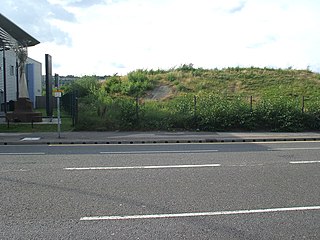
Hallamshire is the historical name for an area of South Yorkshire, England, approximating to the current City of Sheffield local government area.

Darnall ward—which includes the districts of Attercliffe, Carbrook, Darnall, Tinsley, and parts of Handsworth—is one of the 28 electoral wards in City of Sheffield, South Yorkshire, England. It is located in the eastern part of the city and covers an area of 17.4 km2. The population of this ward in 2011 was 23,489 people in 8,809 households. It is one of the wards that made up the Sheffield Attercliffe constituency, now the Sheffield South East constituency.

Worrall is a small rural village in the civil parish of Bradfield, South Yorkshire, England, 4 miles (6.5 km) north west of Sheffield city centre. It has an area of 233 hectares, and population of 1,306 as of 2006, and borders the Sheffield suburbs of Wadsley, Middlewood and Loxley to the south and east and the adjoining village of Oughtibridge to the north; to the west is a rural area extending towards the village of High Bradfield.

Fulwood ward—which includes the districts of Fulwood, Lodge Moor, and Ranmoor—is one of the 28 electoral wards in the City of Sheffield, England. It is located in the far western part of the city and covers an area of 23.2 km2. The population of this ward in 2011 was 18,233 people in 6,476 households. Fulwood ward is one of the five wards that make up the Sheffield Hallam Parliamentary constituency. As of June 2022, Andrew Sangar, Sue Alston, and Cliff Woodcraft, all Liberal Democrats, were councillors for the ward. The current Member of Parliament is Labour's Olivia Blake.

Oughtibridge is a residential village in the north of Sheffield within the bounds of Bradfield civil parish. The village stands about 5 miles (8 km) northwest of the city centre in the valley of the River Don.

Bolton and Undercliffe is an electoral ward in the City of Bradford Metropolitan District Council, England. The population of the ward at the 2011 Census was 16,365. Bolton and Undercliffe covers the area east of Bradford Beck, between Shipley & Wrose to the north and central Bradford to the south. It is a largely urban area.

Darnall railway station is on the Sheffield to Lincoln Line and was built in 1849 to serve Darnall, a community about 3 miles (5 km) from the centre of Sheffield, South Yorkshire, England, and which later became a suburb of the city.

The Lower Don Valley, or historically the East End of Sheffield, is the mainly industrial north-east quarter of Sheffield, England. Located on the River Don, it encompasses the areas of Attercliffe, Brightside, Darnall, Tinsley and Wincobank.

West Tinsley railway station is a former railway station in Sheffield, South Yorkshire, England.
Middlewood is a north western suburb of Sheffield, South Yorkshire, England. The suburb falls within the Stannington ward of the City.
Crookes is a suburb of the City of Sheffield, England, about 1.5 miles (2.4 km) west of the city centre. It borders Broomhill to the south, Walkley and Upperthorpe to the east and open countryside around the River Rivelin to the north. The population of the ward of the same name was 17,700 at the 2011 Census.

Neepsend is a suburb of the city of Sheffield, it stands just 1 mile (1.6 km) north-west of the city centre. The main area of Neepsend covers the flood plain of the River Don from Lady's Bridge at the Wicker up to Hillfoot Bridge. The suburb falls within the Central Ward of the city. The adjacent district of Parkwood Springs is often regarded as part of the suburb.

The A6102 is a 4 digit A road in South Yorkshire, England.

Tinsley is a suburb of north-eastern Sheffield, South Yorkshire, England; it falls within the Darnall ward of the city.

Carbrook is an industrial area of Sheffield, South Yorkshire, England to the south-east of Brightside. The suburb is named for the Carr Brook, which ran through the area until the late eighteenth century.

Darnall is a suburb of eastern Sheffield, South Yorkshire, England. Darnall is approximately 3 miles (5 km) east-north-east of Sheffield city centre.
Burngreave is an inner city district of Sheffield, South Yorkshire, England lying north of the city centre. The population of the ward taken at the 2011 census was 27,481. It started to develop in the second half of the 19th century. Prior to this, this area was mostly covered by Burnt Greave wood. Most of the area of the wood is covered by Burngreave Cemetery which was built in 1860 and extended in the early 1900s. Grimesthorpe Lane, which runs through Burngreave, is a very old road that follows the course of the Roman Rig, a man-made defensive ridge—probably built by the Celtic Brigantes tribe—that used to run from near the Wicker to Mexborough.
Timothy Jollie,, was a nonconformist minister and notable educator in the north of England.

The Darnall Works is a former steelworks in the Darnall area of Sheffield in England. The only remaining large complex of crucible furnaces, the works opened in the 1835 and were frequently extended and adapted until the late 20th century. Some of the structures at the works are listed buildings, at Grade II* and Grade II, and part of the site is a Scheduled Ancient Monument.

Staniforth Road is located in Sheffield, England. It connects the Attercliffe and Darnall areas of the city.




















